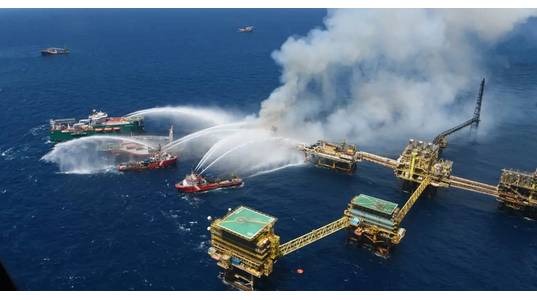
State energy company Pemex released large volumes of methane from an oil platform in the Gulf of Mexico last year, with leaks recurring even after a United Nations agency flagged problems there to the Mexican government, according to a Reuters analysis of previously unreported U.N. data.
The data show that months after academic researchers first reported two major methane leaks from the Zaap-C platform in 2022, the facility still had large and frequent emissions. Pemex has in the past denied any leaks at the platform and did not comment on the new U.N. data.
Reducing methane leaks from oil and gas infrastructure is one of the cheapest and most effective ways to slow climate change in the short term. Mexico is among many countries that have pledged to reduce methane emissions.
Methane is a much more potent driver of climate change in the short term than carbon dioxide because it traps more heat in the atmosphere, tonne for tonne. Recently, new technology has made it easier to find and fix large leaks of the colorless and odorless gas.
Reuters first reported in 2022 that researchers had spotted methane leaking from the platform, most likely because of an issue with a flare at the site. A Mexican senator then filed a criminal complaint that year against the Pemex CEO, the energy minister at that time, and the head of the environmental agency for the oil and gas sector, citing Reuters stories. In Mexico, the status of a criminal complaint is not made public until it is decided.
In 2023, the United Nations Environment Programme’s (UNEP) International Methane Emissions Observatory launched a program to notify governments and energy companies of large methane emissions. The goal is that, once leaks are found and flagged, they will be fixed.
Data from the program was made public on December 1, 2023. Reuters used spatial data analysis tools to look for recurring leaks that had triggered notifications in that data, which describes more than 1,600 methane detections around the world.
Reuters identified a cluster of plumes observed on 25 different days in 2023 off the coast of Mexico, and then discovered that they were at the location of the platform flagged in the 2022 paper. UNEP confirmed the plumes identified by Reuters were from Pemex's Zaap-C platform.
A UNEP spokesman said IMEO, the methane observatory, told the Mexican government about the first nine plumes shortly after identifying them in July. It did not send repeat notifications during the program's first year, so later detections did not trigger notifications. They declined to describe Mexico's response or their communication with the government in more detail.
Neither Pemex nor the president's office, the energy ministry nor the environmental regulator for the oil and gas sector responded to requests for comment.
Reuters could not determine whether Pemex has taken steps to address the leaks. Because UNEP releases data 45 to 75 days after detection, its data does not show whether the platform is leaking now.
A Fixable Problem
Researchers tend to assume the methane plumes they find will be fixed, said Evan Sherwin, a research scientist at the Lawrence Berkeley National Laboratory, who studies methane emissions from oil and gas operations. He was not involved in the Zaap-C paper.
Sherwin said the leak at Zaap-C appeared to be an unlit flare which should be technically feasible to resolve. "This is a fixable problem," he said.
The UNEP monitoring system, set up with support from the United States, the European Union and others, does not impose any consequences if the notifications are ignored.
Mexico is among 156 countries that have promised to reduce methane emissions by at least 30% by 2030 under the voluntary Global Methane Pledge.
The UNEP data showed that methane leaks at the Zaap-C platform were detected in April, May, July, August, September, October and November. Reuters was unable to determine the total volume of methane released.
Scientists analyzing satellite data can estimate the rate that methane is leaking from sites like Zaap-C at single points in time. But because satellites circle the earth and detections depend on things like the position of the sun and clouds, it is rarely possible to know how long platforms are leaking for, and therefore the total volume of methane released.
Manfredi Caltagirone, head of the UN methane observatory, noted the Zaap-C plumes were "very, very significant" emissions, enough to be visible from space.
U.N. data estimated between 13 and just over 100 tonnes of methane per hour were being released into the atmosphere at the times of detection. The International Energy Agency, an intergovernmental organization that publishes data and policy advice on the energy sector, estimated that the entire energy industry released roughly 135 million tonnes of methane in 2022, which works out to about 15,400 tonnes per hour.
Other large leaks have also been linked to unlit flares. Like other companies, Pemex burns off, or flares, gas because it lacks the infrastructure to capture, process and transport it away for other uses.
When the gas is burned in the flare, methane, the main component, converts to carbon dioxide and other components that are less harmful to the environment in the short term.
After Reuters reported on the 2022 detection, Pemex said the scientists had mistaken methane for nitrogen, which is the most plentiful element in the Earth's atmosphere and harmless.
Pemex did not explain how it came to that conclusion. It also did not release the findings of its internal study or respond to Reuters requests for a copy.
The scientists involved in the 2022 study said, in response to Pemex’s statement, that the sensor used to detect methane cannot detect nitrogen.
(Reuters - Reporting by Allison Martell in Toronto and Stefanie Eschenbacher in Mexico City; editing by Claudia Parsons)



